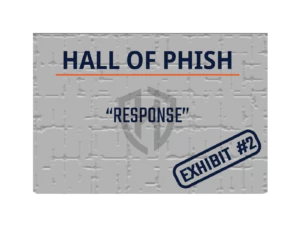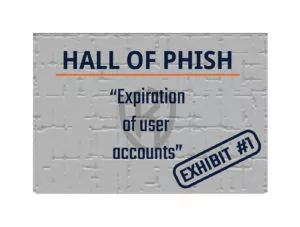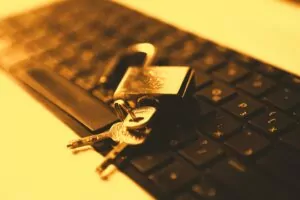October has come and gone. Ghouls and ghosts are slowly being replaced with sparking lights and Christmas trees. That means Cyber Security Awareness Month has come to a close!
The theme this year was, “Do Your Part. #BeCyberSmart”, a reminder that we each play a part in remaining cyber secure!
Cyber Security Basics
The first few days of Cyber Security Awareness Month looked at a few cyber security basics, including:
- What is cyber security? Generally, it’s all aspects of keeping computers and the information they contain protected from being lost to malicious or accidental causes.
- Who needs cyber security? Everyone!
- Why should I be cyber secure? We all want to keep our personal information personal and key business knowledge private. Why not do what we can to make sure it stays that way!
Week 1: If You Connect It, Protect It
Week 1 officially kicked off on October 5th and focused on the theme, “If You Connect It, Protect It”. We delved into the following topics:
Laptops
Never leave your laptop anywhere it can be easily seen. Lock it in the trunk if you’re travelling. If you have to leave it out in the open, use a locking cable as a deterrent.
Cell Phone Apps
Certain apps can steal your contacts, look at your call history, and even read your text messages. Always be sure to check what permissions an app wants before you install it!
USB Keys
Computer viruses can travel from machine to machine as you plug USB keys into them. Always keep your USB key on your person, never lend it to anyone else, or plug in a strange USB key to your computer!
Connecting Devices While Travelling
Always make sure to bring your device chargers – with the plug! – with you when you travel, and not just the USB cable.
Social Media
Be sure to check your social media’s privacy setting to ensure that the email address, phone number, or address you used to sign up aren’t out on public display for everyone to see!
Digital Home Devices
Many digital home devices have microphones that are always on. They can transmit what they hear back to the company who manufactured it, turning your private conversations public. It’s a good idea to periodically log in to the website for the device and clear the recording history.
Week 2: Securing Devices at Home and at Work
Week 2 brought us the theme of, “Securing Devices at Home and at Work”. This week, we looked at topics to help us remain cyber secure at home and at the office, including:
Password Managers
Using a password manager means that you only have to remember a single password. It does all the heavy lifting and remembers each and every one of your passwords for you! Bonus: using the password generator on a password manager allows you to have completely unique passwords for every site you use! This makes it harder for cyber criminals to guess your login information.
Patching
Patching, or applying software updates to applications (like those on your cell phone), operating systems (like Windows), and devices (like routers and firewalls) is an important part of remaining cyber secure. Turn on automatic updates to ensure you stay protected!
Physical Tokens
Used to log in to accounts and applications as part of Multi-Factor Authentication (more about that below), physical tokens provide an extra layer of assurance that the person trying to access an account really is who they say they are, because they physically possess something they were given.
Multi-Factor Authentication (MFA)
MFA allows you to use at least two different ways to prove that you are who you say you are when you’re logging into a system or application. Chances are, any attacker trying to access your accounts will only have one of two factors and won’t be able to complete their attack.
Wi-Fi Passwords
It’s good practice for businesses to regularly change their Wi-Fi passwords – especially for guest Wi-Fi networks. It’s also a good idea to keep the password hidden so that if anyone wants to connect, they have to ask for the password first!
Phishing
Phishing involves the various things that hackers do to get your personal information. It could be usernames, passwords, or even banking details. Make sure to not click on any suspicious links or email attachments, especially those that you aren’t expecting.
Week 3: Securing Internet-Connected Devices in Healthcare
Health and wellness were at the forefront of Week 3’s theme of, “Securing Internet-Connected Devices in Healthcare”. We touched on:
Personal Medical Devices
Pacemakers or blood-glucose monitors are good examples of things you need to keep secure. Make sure to check your device’s settings to safeguard your personal information!
Wellness Apps
Information you share with your Fitbit or Apple wellness apps such as could be made available to them for their own use. If you’re not comfortable sharing your medical data, check your settings to ensure that only the information you want out in public is all that is being shared!
Medical Records
Much like your DNA, medical records can’t (and shouldn’t) be altered. Are you concerned about the security of your medical records? Reach out to your healthcare provider to ensure your information is being properly protected.
Ransomware
Health care and ransomware: two unlikely thoughts but they can go hand in hand! Cyber attackers have been found to use ransomware to keep important medical records from those who need it the most. Performing regular backups is a good way to keep your data safe, ensuring that you don’t have to shell out money unexpectedly to a cyber attacker.
Telemedicine
It’s becoming more commonplace to connect with your physician virtually or over the phone. When discussing your health with your doctor, make sure you are in a private location. Stay off of public wi-fi if you are having a video call and be aware of your surroundings when talking aloud about personal medical matters.
Physical Security
Ensure your workstation is locked before you leave it, keeping any information on your workstation safe. At the office after hours? Make sure the door closes behind you before you head back to your desk. Most importantly, don’t hold the door open for someone you don’t know.
Legacy Systems
Any device for which manufacturers no longer provide updates for are known as Legacy Systems. With no updates, these devices are the most vulnerable to cyber attacks. Replace legacy systems with newer devices that are still being supported by their manufacturers, and be sure to keep them updated!
Week 4: The Future of Connected Devices
Finally, we looked to the future in week 4 as we talked about, “The Future of Connected Devices”. The world is what we make of it, and cyber security is no exception, as we considered:
Artificial Intelligence
Imagine if a machine could consider all possible outcomes of a cyber attack – the most skilled attacker could be thwarted before they really began!
Hackers
Originally meaning someone who uses technical know-how to overcome a challenge, today the term ‘hacker’ is associated with illegal activities.
Cognitive Security and AI
Have you ever thought about how it can be used to strengthen security? In understanding how humans think, AI can rapidly evaluate evolving situations and security postures, far faster than any human brain could process it. Imagine that your IT department has built you a network for your business. AI can look at the network, see how it interconnects, and locate any potential security gaps before hackers can expose them. This would afford you the unique opportunity to close those gaps and be more secure!
5G
This fifth-generation cellular network will bring fast speeds and reliable connectivity to new places. This will drive the explosion of “Internet of Things” (IoT) devices including smartphones and digital home devices such as smart thermostats. With this rapid adoption of IoT, cyber security must be at the forefront to keep you and your devices safe. Be sure to check your permissions settings. Update your devices regularly as you bring them into your everyday life!
Looking to the Future
Cyber Security Awareness Month may be over, there is so much we have yet to share with you! New blog articles will be posted on our website regularly. Tips, tricks, tidbits, and maybe even the odd funny can be found on our Instagram, Twitter, and Facebook accounts. Follow us today so you don’t miss out! We look forward to sharing our knowledge with you to help you and your business #BeCyberSmart and stay protected!












